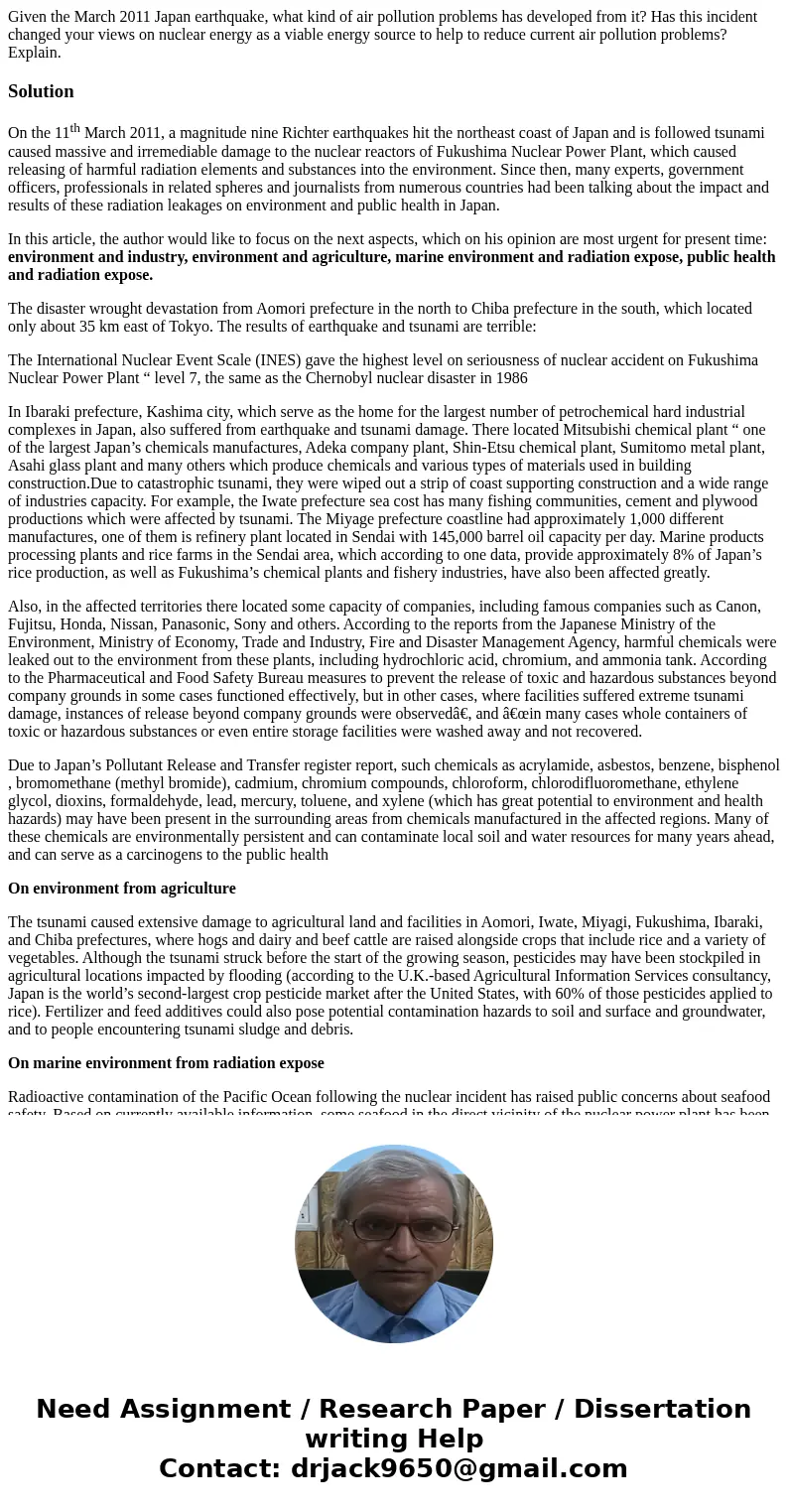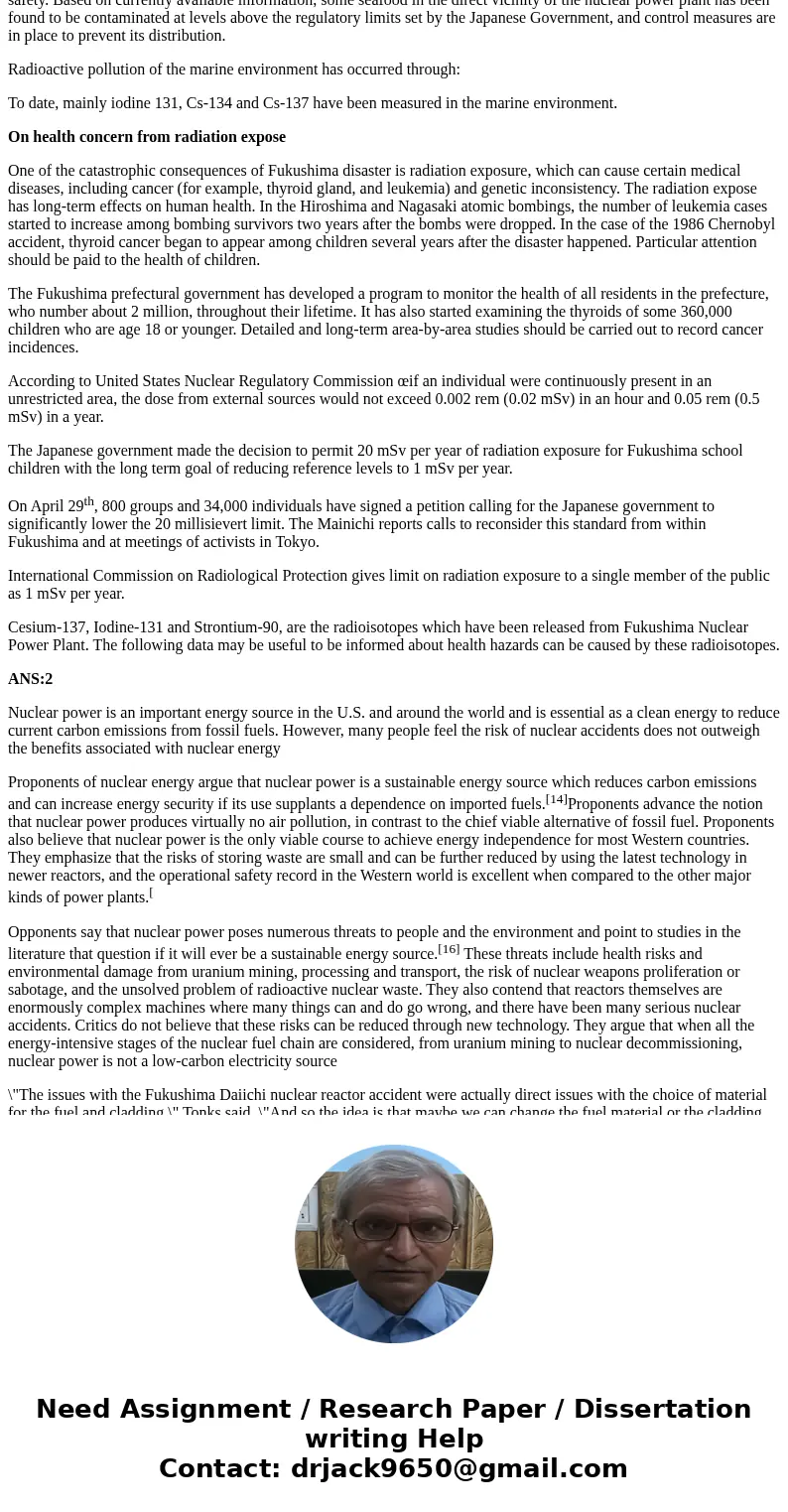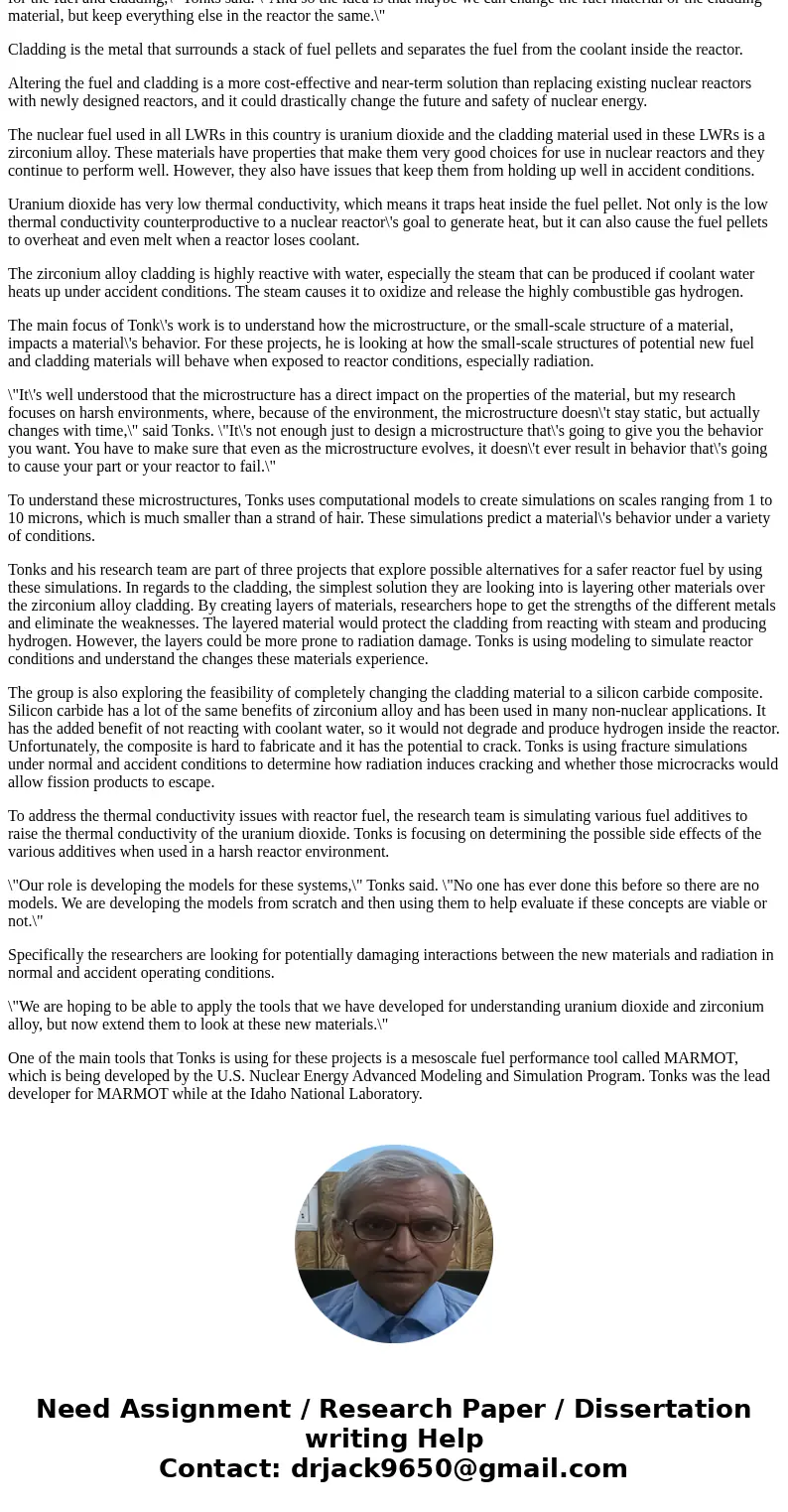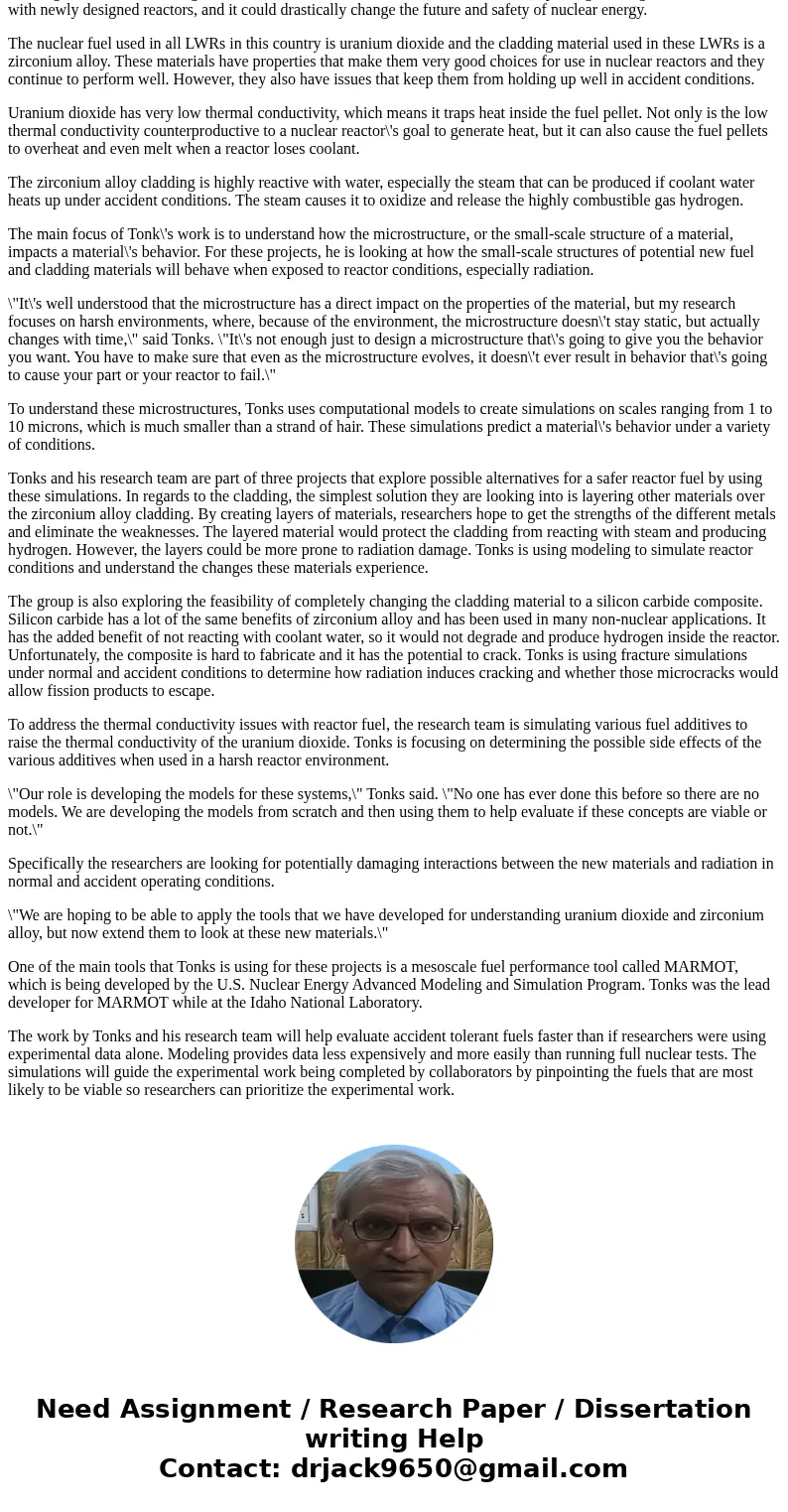Given the March 2011 Japan earthquake what kind of air pollu
Given the March 2011 Japan earthquake, what kind of air pollution problems has developed from it? Has this incident changed your views on nuclear energy as a viable energy source to help to reduce current air pollution problems? Explain.
Solution
On the 11th March 2011, a magnitude nine Richter earthquakes hit the northeast coast of Japan and is followed tsunami caused massive and irremediable damage to the nuclear reactors of Fukushima Nuclear Power Plant, which caused releasing of harmful radiation elements and substances into the environment. Since then, many experts, government officers, professionals in related spheres and journalists from numerous countries had been talking about the impact and results of these radiation leakages on environment and public health in Japan.
In this article, the author would like to focus on the next aspects, which on his opinion are most urgent for present time: environment and industry, environment and agriculture, marine environment and radiation expose, public health and radiation expose.
The disaster wrought devastation from Aomori prefecture in the north to Chiba prefecture in the south, which located only about 35 km east of Tokyo. The results of earthquake and tsunami are terrible:
The International Nuclear Event Scale (INES) gave the highest level on seriousness of nuclear accident on Fukushima Nuclear Power Plant “ level 7, the same as the Chernobyl nuclear disaster in 1986
In Ibaraki prefecture, Kashima city, which serve as the home for the largest number of petrochemical hard industrial complexes in Japan, also suffered from earthquake and tsunami damage. There located Mitsubishi chemical plant “ one of the largest Japan’s chemicals manufactures, Adeka company plant, Shin-Etsu chemical plant, Sumitomo metal plant, Asahi glass plant and many others which produce chemicals and various types of materials used in building construction.Due to catastrophic tsunami, they were wiped out a strip of coast supporting construction and a wide range of industries capacity. For example, the Iwate prefecture sea cost has many fishing communities, cement and plywood productions which were affected by tsunami. The Miyage prefecture coastline had approximately 1,000 different manufactures, one of them is refinery plant located in Sendai with 145,000 barrel oil capacity per day. Marine products processing plants and rice farms in the Sendai area, which according to one data, provide approximately 8% of Japan’s rice production, as well as Fukushima’s chemical plants and fishery industries, have also been affected greatly.
Also, in the affected territories there located some capacity of companies, including famous companies such as Canon, Fujitsu, Honda, Nissan, Panasonic, Sony and others. According to the reports from the Japanese Ministry of the Environment, Ministry of Economy, Trade and Industry, Fire and Disaster Management Agency, harmful chemicals were leaked out to the environment from these plants, including hydrochloric acid, chromium, and ammonia tank. According to the Pharmaceutical and Food Safety Bureau measures to prevent the release of toxic and hazardous substances beyond company grounds in some cases functioned effectively, but in other cases, where facilities suffered extreme tsunami damage, instances of release beyond company grounds were observedâ€, and “in many cases whole containers of toxic or hazardous substances or even entire storage facilities were washed away and not recovered.
Due to Japan’s Pollutant Release and Transfer register report, such chemicals as acrylamide, asbestos, benzene, bisphenol , bromomethane (methyl bromide), cadmium, chromium compounds, chloroform, chlorodifluoromethane, ethylene glycol, dioxins, formaldehyde, lead, mercury, toluene, and xylene (which has great potential to environment and health hazards) may have been present in the surrounding areas from chemicals manufactured in the affected regions. Many of these chemicals are environmentally persistent and can contaminate local soil and water resources for many years ahead, and can serve as a carcinogens to the public health
On environment from agriculture
The tsunami caused extensive damage to agricultural land and facilities in Aomori, Iwate, Miyagi, Fukushima, Ibaraki, and Chiba prefectures, where hogs and dairy and beef cattle are raised alongside crops that include rice and a variety of vegetables. Although the tsunami struck before the start of the growing season, pesticides may have been stockpiled in agricultural locations impacted by flooding (according to the U.K.-based Agricultural Information Services consultancy, Japan is the world’s second-largest crop pesticide market after the United States, with 60% of those pesticides applied to rice). Fertilizer and feed additives could also pose potential contamination hazards to soil and surface and groundwater, and to people encountering tsunami sludge and debris.
On marine environment from radiation expose
Radioactive contamination of the Pacific Ocean following the nuclear incident has raised public concerns about seafood safety. Based on currently available information, some seafood in the direct vicinity of the nuclear power plant has been found to be contaminated at levels above the regulatory limits set by the Japanese Government, and control measures are in place to prevent its distribution.
Radioactive pollution of the marine environment has occurred through:
To date, mainly iodine 131, Cs-134 and Cs-137 have been measured in the marine environment.
On health concern from radiation expose
One of the catastrophic consequences of Fukushima disaster is radiation exposure, which can cause certain medical diseases, including cancer (for example, thyroid gland, and leukemia) and genetic inconsistency. The radiation expose has long-term effects on human health. In the Hiroshima and Nagasaki atomic bombings, the number of leukemia cases started to increase among bombing survivors two years after the bombs were dropped. In the case of the 1986 Chernobyl accident, thyroid cancer began to appear among children several years after the disaster happened. Particular attention should be paid to the health of children.
The Fukushima prefectural government has developed a program to monitor the health of all residents in the prefecture, who number about 2 million, throughout their lifetime. It has also started examining the thyroids of some 360,000 children who are age 18 or younger. Detailed and long-term area-by-area studies should be carried out to record cancer incidences.
According to United States Nuclear Regulatory Commission œif an individual were continuously present in an unrestricted area, the dose from external sources would not exceed 0.002 rem (0.02 mSv) in an hour and 0.05 rem (0.5 mSv) in a year.
The Japanese government made the decision to permit 20 mSv per year of radiation exposure for Fukushima school children with the long term goal of reducing reference levels to 1 mSv per year.
On April 29th, 800 groups and 34,000 individuals have signed a petition calling for the Japanese government to significantly lower the 20 millisievert limit. The Mainichi reports calls to reconsider this standard from within Fukushima and at meetings of activists in Tokyo.
International Commission on Radiological Protection gives limit on radiation exposure to a single member of the public as 1 mSv per year.
Cesium-137, Iodine-131 and Strontium-90, are the radioisotopes which have been released from Fukushima Nuclear Power Plant. The following data may be useful to be informed about health hazards can be caused by these radioisotopes.
ANS:2
Nuclear power is an important energy source in the U.S. and around the world and is essential as a clean energy to reduce current carbon emissions from fossil fuels. However, many people feel the risk of nuclear accidents does not outweigh the benefits associated with nuclear energy
Proponents of nuclear energy argue that nuclear power is a sustainable energy source which reduces carbon emissions and can increase energy security if its use supplants a dependence on imported fuels.[14]Proponents advance the notion that nuclear power produces virtually no air pollution, in contrast to the chief viable alternative of fossil fuel. Proponents also believe that nuclear power is the only viable course to achieve energy independence for most Western countries. They emphasize that the risks of storing waste are small and can be further reduced by using the latest technology in newer reactors, and the operational safety record in the Western world is excellent when compared to the other major kinds of power plants.[
Opponents say that nuclear power poses numerous threats to people and the environment and point to studies in the literature that question if it will ever be a sustainable energy source.[16] These threats include health risks and environmental damage from uranium mining, processing and transport, the risk of nuclear weapons proliferation or sabotage, and the unsolved problem of radioactive nuclear waste. They also contend that reactors themselves are enormously complex machines where many things can and do go wrong, and there have been many serious nuclear accidents. Critics do not believe that these risks can be reduced through new technology. They argue that when all the energy-intensive stages of the nuclear fuel chain are considered, from uranium mining to nuclear decommissioning, nuclear power is not a low-carbon electricity source
\"The issues with the Fukushima Daiichi nuclear reactor accident were actually direct issues with the choice of material for the fuel and cladding,\" Tonks said. \"And so the idea is that maybe we can change the fuel material or the cladding material, but keep everything else in the reactor the same.\"
Cladding is the metal that surrounds a stack of fuel pellets and separates the fuel from the coolant inside the reactor.
Altering the fuel and cladding is a more cost-effective and near-term solution than replacing existing nuclear reactors with newly designed reactors, and it could drastically change the future and safety of nuclear energy.
The nuclear fuel used in all LWRs in this country is uranium dioxide and the cladding material used in these LWRs is a zirconium alloy. These materials have properties that make them very good choices for use in nuclear reactors and they continue to perform well. However, they also have issues that keep them from holding up well in accident conditions.
Uranium dioxide has very low thermal conductivity, which means it traps heat inside the fuel pellet. Not only is the low thermal conductivity counterproductive to a nuclear reactor\'s goal to generate heat, but it can also cause the fuel pellets to overheat and even melt when a reactor loses coolant.
The zirconium alloy cladding is highly reactive with water, especially the steam that can be produced if coolant water heats up under accident conditions. The steam causes it to oxidize and release the highly combustible gas hydrogen.
The main focus of Tonk\'s work is to understand how the microstructure, or the small-scale structure of a material, impacts a material\'s behavior. For these projects, he is looking at how the small-scale structures of potential new fuel and cladding materials will behave when exposed to reactor conditions, especially radiation.
\"It\'s well understood that the microstructure has a direct impact on the properties of the material, but my research focuses on harsh environments, where, because of the environment, the microstructure doesn\'t stay static, but actually changes with time,\" said Tonks. \"It\'s not enough just to design a microstructure that\'s going to give you the behavior you want. You have to make sure that even as the microstructure evolves, it doesn\'t ever result in behavior that\'s going to cause your part or your reactor to fail.\"
To understand these microstructures, Tonks uses computational models to create simulations on scales ranging from 1 to 10 microns, which is much smaller than a strand of hair. These simulations predict a material\'s behavior under a variety of conditions.
Tonks and his research team are part of three projects that explore possible alternatives for a safer reactor fuel by using these simulations. In regards to the cladding, the simplest solution they are looking into is layering other materials over the zirconium alloy cladding. By creating layers of materials, researchers hope to get the strengths of the different metals and eliminate the weaknesses. The layered material would protect the cladding from reacting with steam and producing hydrogen. However, the layers could be more prone to radiation damage. Tonks is using modeling to simulate reactor conditions and understand the changes these materials experience.
The group is also exploring the feasibility of completely changing the cladding material to a silicon carbide composite. Silicon carbide has a lot of the same benefits of zirconium alloy and has been used in many non-nuclear applications. It has the added benefit of not reacting with coolant water, so it would not degrade and produce hydrogen inside the reactor. Unfortunately, the composite is hard to fabricate and it has the potential to crack. Tonks is using fracture simulations under normal and accident conditions to determine how radiation induces cracking and whether those microcracks would allow fission products to escape.
To address the thermal conductivity issues with reactor fuel, the research team is simulating various fuel additives to raise the thermal conductivity of the uranium dioxide. Tonks is focusing on determining the possible side effects of the various additives when used in a harsh reactor environment.
\"Our role is developing the models for these systems,\" Tonks said. \"No one has ever done this before so there are no models. We are developing the models from scratch and then using them to help evaluate if these concepts are viable or not.\"
Specifically the researchers are looking for potentially damaging interactions between the new materials and radiation in normal and accident operating conditions.
\"We are hoping to be able to apply the tools that we have developed for understanding uranium dioxide and zirconium alloy, but now extend them to look at these new materials.\"
One of the main tools that Tonks is using for these projects is a mesoscale fuel performance tool called MARMOT, which is being developed by the U.S. Nuclear Energy Advanced Modeling and Simulation Program. Tonks was the lead developer for MARMOT while at the Idaho National Laboratory.
The work by Tonks and his research team will help evaluate accident tolerant fuels faster than if researchers were using experimental data alone. Modeling provides data less expensively and more easily than running full nuclear tests. The simulations will guide the experimental work being completed by collaborators by pinpointing the fuels that are most likely to be viable so researchers can prioritize the experimental work.




 Homework Sourse
Homework Sourse